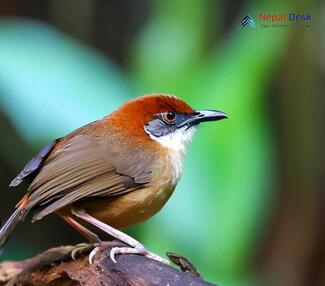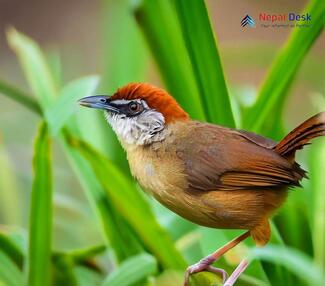Nestled within the heart of the Asian continent, Nepal is home to an extraordinary variety of bird species, thanks to its unique geographic location and varying climate. One such captivating bird is the Chestnut-capped Babbler (Timalia pileata), a small yet vibrant songbird that can be found dwelling in the dense forests and undergrowth of Nepal's lush countryside. In this article, we will journey into the enchanting world of the Chestnut-capped Babbler to explore its habitat, appearance, behavior, and conservation status.
A Haven for Bird Enthusiasts: The Habitat of the Chestnut-capped Babbler
The Chestnut-capped Babbler thrives in subtropical and tropical climates found at lower elevations throughout Nepal. These environments offer mixed vegetation, which provides ideal nesting opportunities for these birds as they favor areas with dense undergrowth for protection from predators. Additionally, their preferred habitats include tall grasslands bordering rivers and streams, where they can easily forage for food.
A Colorful Sight To Behold: The Appearance of the Chestnut-capped Babbler
The beauty of the Chestnut-capped Babbler lies in its striking physical characteristics. Possessing a rich chestnut-colored cap on their head – as their name suggests – these birds provide a stark contrast against their olive-brown bodies. They have a white throat and bright buff-colored underparts highlighted by striking black streaks on their flanks. Their narrow curved beaks are perfect for catching insects, while their zygodactyl feet (two toes facing forward and two facing backward) enable them to navigate through thick foliage with ease.
A Symphony in the Forest: The Behavior of the Chestnut-capped Babbler
Chestnut-capped Babblers are social creatures that travel in small, tight-knit groups while maintaining a constant chorus of calls. These calls can range from soft chirps to louder, more noticeable sounds that echo throughout the forest. Their diet largely consists of insects, including beetles and caterpillars, which they catch by hopping along the ground or searching amidst vegetation. Although they are agile birds, they are rarely seen in flight and prefer to move about by hopping or climbing.
The Need for Conservation Efforts: Protecting the Chestnut-capped Babbler
While the Chestnut-capped Babbler is not considered to be an endangered species, ongoing habitat loss is of considerable concern in Nepal. Deforestation and urban development have resulted in depleted natural habitats for these birds. Consequently, it is imperative that conservation efforts prioritize the protection and restoration of their habitats. This will ensure that future generations can enjoy the captivating presence of these charming songbirds.
In conclusion, the Chestnut-capped Babbler is a fascinating bird native to Nepal that captivates birdwatchers and nature enthusiasts alike. Its unique appearance, melodic calls, and lively behavior make it a delightful sight amidst Nepal's diverse landscape. By striving to preserve its natural habitat through conservation efforts, we can ensure that this charming little songbird continues to thrive within the vibrant forests of Nepal for years to come.




